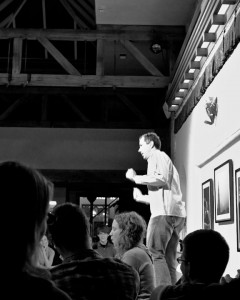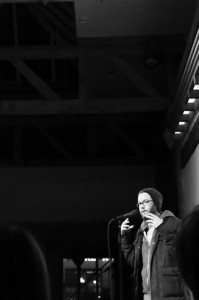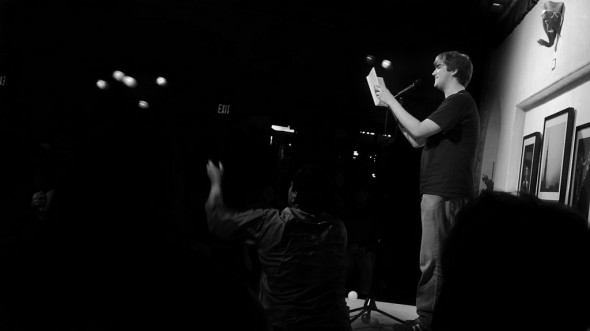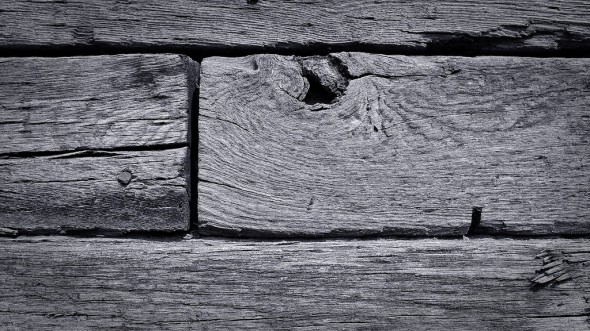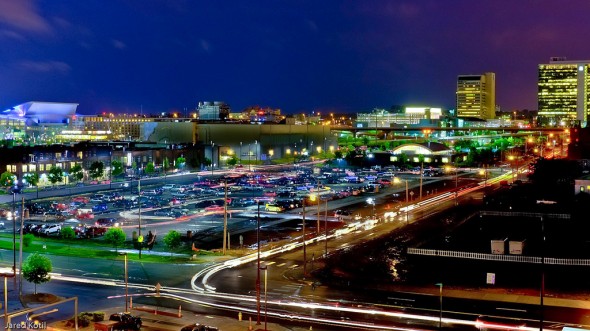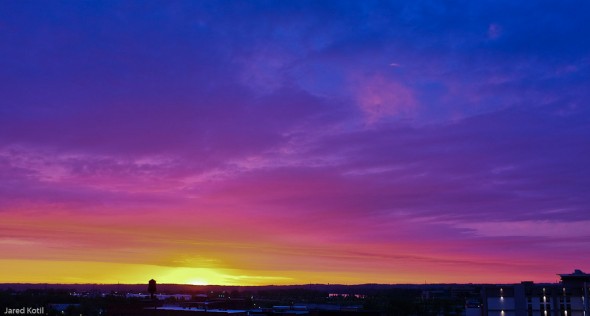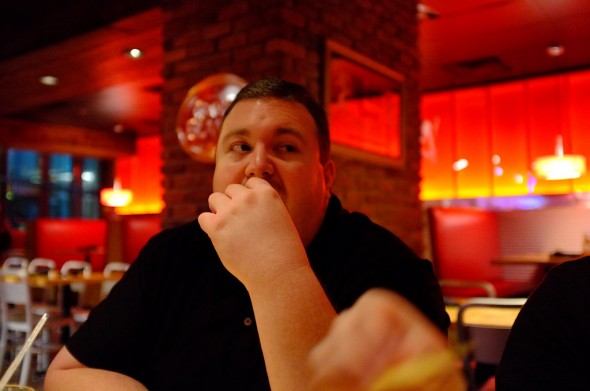Here is another guest post review of the Fujifilm Finepix X100 camera from TaoTeJared . Don't forget to enter also the ongoing Fuji X100 giveaway. Check also the previous X100 review.
In the last 3 weeks and almost at 1000 shots later with the Fujifilm X100 camera, I can honestly say I am loving it more every day. It has replaced my daily "Out the door -Grab Cam" Canon G11 and I have not touched my Nikon FE2 (50mm f/1.8 E-series or sigma 24mm f/2.8 MF lenses) or my Voigtlander BessaR2 (35mm f/2.5 Skopar or Jupiter 50mm f/2) for the last two weeks which is rare for me. Below are some of my experiences and impressions after using the X100 almost non-stop in a variety of situations from bright day light, dark bars, small stage, long shutter timing, sunrises, sunsets, people, dogs and anything and everything else.
There are 100's of reviews out there, so let's get two things out of the way about the reviews, some of which I find really amusing. I find many discussions and some reviews focus on the desire of wanting something different that diverts attention from what the X100 was designed for and what it is capable of, which is unfortunate and very dismissive of the intentions of this tool.
Note 1 For the "That's not what I wanted!" crowd: The X100 is certainly a “stylistic” type of camera and Fuji has made an honorable effort to say this, and has not given any impression it is suppose to be something different than a stylistic camera. One thing is for sure, just like Helga, Diana, Polaroid, Leica, Voigtlander, Zeiss lenses, this is a wonderful tool and is not a gimmick. It was designed with specific aspirations, and either it fits your style, or it doesn’t. There are a lot of vocal criticisms from people who have not used it for its limitations, (valid or not) as they want something other than this camera. One could apply many of those words to any of the brands I mentioned before, or to even their camera phones that they probably use more than any camera system. As it applies to the X100, I find it unproductive, and becomes rather narcissistic and self-centered to think that everything must be designed to be an all-in-one system rather than seeing the opportunities this camera can provide.
I do think it shows a strong desire for a retro stylistic compact system, with very high ISO (3200+) performance that matches the new DSLR releases and is beyond the m4/3 and other the other mirror-less systems performance levels. This camera hits the nail on the head on every aspect but the lens.
Current Reviews: There are a lot of reviews out there and I think have read almost all of them. Opinions are Good, Bad, or the more abundant, "Ehh seems ok, but I don't get IT". The one thing I have observed, is that there seems to be three main types of reviews covering the Fujifilm X100:
Type 1: The standard Magazine (type of) Review. Money is no object as they get it free or it is just a cost of doing business. They get a camera maybe for a week or two at most, are told to quickly use it almost always in a studio, write a review, and then return it. This is normal, and is not unlike any other camera they test. These are valuable, but I find that they often don't have a vested interest in learning to "Use the Camera As Designed," are limited on time, deadlines, and are there to give their first impression and move on to the next big thing. I'm sure many in this line of work are disappointed by the unfortunate time restraints put on them and they are not able to spend all the time needed to master the capabilities of most of the various advanced camera systems they get to see and try.
Type 2: The User. (This includes me.) Purchased the camera based on promises, looks, and wow factor. Researched like crazy to see what others were saying. Shelling out that much for a camera is rare and hurts. Has a fully vested interest in learning everything about the camera as they will be using it hopefully longer than it takes to pay it off from the credit card. Was looking for a low light, high image quality, carry everywhere camera so they don't have to lug their DSLR every ware they go. Understood limitations of a single focal length, and either saw the trade off was acceptable for the fast lens and low light capability, and/or did not see a single focal length as a limitation. Learns to "Use the Camera as Designed" to achieve desired results. Still hiding it from wife/husband or partner.
Type 3: The Idiot. (This really overstates and encompasses many separate individuals and their traits into one group -work with me here.) Likes shiny and new things. Does very little research before purchases. Is often disappointed. (Derived from their other reviews where almost everything is lackluster.) Has money to burn or is just not rational in its usage. Wants the camera to conform to their shooting style as a DSLR does. Doesn't care how it was designed and wants their individual desires delivered upon. Fights technology tooth and nail until the device buckles to their will or they send it back for a refund. Wants an Interchangeable Lens Camera(ILC) / Mirror-less camera, but still purchased a X100 and was very disappointed that it did not have interchangeable lenses and dumbfounded how anyone could shoot without a zoom. Would not buy a Polaroid or if did, would complain about having to buy and scan film.
Why have I taken you though my descriptions of these types? Two have something in common as you may have already guessed. Either by situation or choice, Type 1 & 3 reviews have not taken or had the adequate time necessary to learn how to use this very capable and unique camera. Being unique, there is not quite anything out there like it, and the time to learn the camera, even to a advanced DSLR user, is steeper than most. One probably needs a very good understanding of photography as well. There are hidden "treasures" by using different buttons, dial, and command toggle that is needs to be learned for its full potential to be released. (All are described in the manual but are very easy to overlook when just skimming.) Being that as it is, it takes a commitment and desire to learn is not unlike any advanced or pro DSLR.
I have not seen many, reviews acknowledge this, or that have been able to master the X100 in the time they spent with the camera before writing the review. Some even seem exhausted and just gave up rather than learn it. They have treated it like a compact or Interchangeable Lenses system designed for the basic user. Again, this camera was NOT designed for a basic user upgrading to a better camera and should be kept in mind. This camera was designed for the advanced amateur or pro who wants with a strong knowledge about photography something smaller with the same image quality. I acknowledge that I have not learned everything about the X100 and will need more time to shoot as freely as I do my DSLR. But that can be said about all the advanced features I seldom use, on my Nikon D300 after almost 3 years.
Recap: (Because people need to understand and should not be misled.) Advanced system that has a DSLR learning curve and it is not intended for everyone. Good, let's get to the nit and gritty of the camera
Down to the details
I am not going to cover the items everyone else have covered and are not in contention or the supper technical MF charts etc. I believe everyone has covered those sufficiently and in most review all they cover. I will cover some of the contested, overly focused and misinformed items that I have seen. I will also include some notes of what settings I use and which settings I find the easiest to work with.
(For a reference point and where my base of my opinions originate from: I have shot at length, Nikon D300/90/80/70/50, Canon G9/11, Olympus Ep-1, Many Digi cams from Canon and Panasonic. Film: Canon Elan IIe, Nikon N90/75/65, FE2/FG20, Pentax Super ME, Voigtlander Bessa-R2, and many of the Olympus IS film camera line. I currently and regularly shoot: Nikon D300, D50 Infrared, Nikon FE2, Voigtlander Bessa-R2, Canon G11, Olympus Ep-1, and of course, my iPhone.)
Design (other than looks)
Layout of buttons are where they should be and becomes intuitive quickly (similar to Nikon's system and Canon's G11). Many buttons have multiple purposes depending on the Mode/menu/macro vs. normal and are well thought out but not well documented and can be missed if not thorough with the manual. It takes some learning and, do I dare say READING the manual. In actual use, I found that it becomes 2nd nature quickly.
Viewfinder
Just plain Nuts! Way to go Fuji!!! I love this thing and have never seen anything like it and as usable. The viewing options between the viewfinder and rear display can complement each other, mirror each other, or have the ability to use one or the other. A push of one of two buttons changes all of this quickly. The ability to see menu choices and other items without having to move your eye from the viewfinder is a huge plus. The rear display turns off and automatically transfers it's display to the viewfinder by just raising the camera to your eye. This caught me off guard at first, but is great when you need to make a quick change while shooting. The viewfinder has the option for two different grids and horizon level is easily visible in bright light but not overbearing or obtrusive at all. Once thing I will say, in low light with the level and grid on, it is too bright at times in low light situations. Switching the grid and level off is just a button push away or switching to the OVF mode in low light is the way to go on this camera. The OVF is similar to every OVF out there and is very good especially in low light. One should experience it at least once if they can get a chance too. I would love to see some of the design aspects in other cameras for sure.
Autofocus
- Daylight: Quick and snappy -Not DSLR/D300 wicked fast, but faster than the Oly EP1, Canon G11 and I have found it does not hamper or limit getting photos at all. This slowness is only noticeable when shot alongside my D300.
- Low light: Slow for sure if there is not a bright light on a single subject. That said, I was at a poetry slam in a very dark room with a light on the performer on stage and snapped to the selected AF point on the performer almost as fast as daylight and I had very few missed shots.
- AF-C: My guess this is where the "2-day tester" have set the camera to and are not happy with. It can be a bit finicky, but not unlike any other contrast detection cameras when there is not just one well defined, high contrast ,focus point. I just use AF-S mode, put the focus point on the subject, and snaps right to it, AF lock it, and recompose. This is how I shoot normally and I don't even use AF-C on my D300 or any other camera so this is not a big deal to me.
- Macro: Not the best, but is not bad either. Considering that I use the 105mm VR and 60mm Nikkors, not much can go toe to toe with those so my opinion of a great Macro is quite biased. The quality is just about the same as the 35mm f/1.8 G lens minus the fact that it cannot focus near as close as the X100. Stopping down to f/8 -f/16 gets the best results. Forget about macro in low light -this camera is not built for that.
- Close focus: IQ does increase quickly with distance and especially when shooting at f/2. At f/5.6 on up, everything is supper sharp which is probably due more to the focus depth at this distance than the lens itself. 1/3 meter and greater ,the IQ is very good. The close focus of 1m and anything closer having to switch to macro mode is cumbersome. Reviewers complain about this, but getting to focus that close is something I could not do with my Nikkor 24mm 2.8 so I find it as a big bonus rather than a drawback. The nice thing is that you don't have to take your eye from the viewfinder to change the camera to macro mode.
- Key learning suggestion: Learn to use the AF Lock as it is very helpful for all situations for this camera, and any other systems.
- Manual focus: there is no live MF override -you have to switch the camera to MF. Many reviewers act like this exists and harp that MF is terrible because they are trying use a non-existent override to tune the focus, that didn't need it anyway. Just because it turns...Who didn't read their manual? Manual focusing is not like a 50mm MF lens from 1960. I'm not sure why anyone believes why it should be that way to be honest. The focus turn resembles more of a macro going from infinity down to a very close subject. Really reminds me of doing this with my 105mm VR. This is an auto-focus camera with MF option.
- Tip 1: In MF mode, align the focus point and press the AFL/AEL button and it auto-focuses to that point. You can then fine tune focus as a zoomed image appears.
- Tip 2: If you turn the focus ring very quickly (almost in a jerky way), the focus moves very quickly. Don't be shy about this as it takes a really good twist for it to move. Since the button layout is very intuitive, all of this becomes 2nd nature quickly.
Auto ISO
Works just like Nikon and works very well. Not much more to say about this.
Full Auto mode
This thing really shines in auto mode -even outdoes me many times. I kid, but it is nice to know when I am just "snap shooting" it handles everything as it should.
Video
Basics: 1280x720p (HD): 24 fps -Internal Stereo Microphone -H.264 .MOV -10 min time constraint. I will fully admit that I am not a video person at all. I think I have shot a total of 5 min of video over the last 10 years and probably only with my cell phone. What I can tell as a bystander is that the AF is ok, it is not real jerky, and that is about it.
There are some a few good videos popping up on YouTube but I really have no clue how to identify any production qualities to say if it is good or not.
Panoramic Mode
Basics: 120 degrees or 180 degrees. Here is another thing that I have never used before so I really don't have an opinion on. Auto stitch can be off but that probably has more to do with the user than the camera.
Exposure
Spot on 90% of the time and about -1/2 stop the other 10% of the time. All aperture and shutter settings are in 1-stop increments so this is not a surprise. Some have seen some under and over exposures that happen in A and S modes. Again, "Read the manual hurry some reviewers." This is due to a lack of good warning or stopping from a photo being taken due to the combination of incomparable shutter and aperture settings. Example, top shutter speed at F2 is only 1000 but the shutter dial will go to 4000. You have to stop-down to get 4000. Shutter speed shows red in the viewfinder warning you. The design is because at a shutter of 4000, the leaf shutter blades just can't get full open at those speeds. The solution is to turn on the ND filter to shoot F2 in bright sunlight.
Dynamic Range settings
All settings have a small bias towards shadow detail.
100%: Normal mode. All ISO-s are available.
200%: Small extension of range of Shadow detail. ISO 400 on up only.
400%: Keeps the shadow detail and extends the highlight detail. ISO 800 on up only.
Color modes
- Provia (STD) : Gives the most and best Dynamic Range. Good color with a small punch to it. Most usable files come from this setting. I kicked Saturation up a step and contrast up a step as well. I like it and have shot probably 70% of my images in this setting.
- Astia (POR): Losses some shadow detail but keeps highlights. 2nd favorite setting. Good primary colors and slightly muted and soft secondary tones.
- Velvia: Lowest Dynamic Range (And highest contrast of the color modes.) Clips shadow detail the most. Holds highlights well. High saturation. I have left the saturation at default settings and contrast one stop down. Files: Mixed bag for me as I like them out of the camera at times, but are limited in workability in Lightroom 2. Noise reduction with Lightroom 2, Noise Ninja, and Nik Define 2 all erase detail very easily. If you are shooting a normal, mid contrast scene, Velvia shines. In a high saturation (Sunrise/sunset) where DR is the name of the game, Provia is your best bet.
- B&W: Same DR if not a bit better than Provia. I have switched to ISO 3200 and shot at this all night at times. Amazing files. I have pushed the contrast up and usually set the exposure compensation to -1 for my personal taste. Personally I would rather have black shadows than Noisy ones.
- B&W with filters (RYG): Small losses in DR depending on filter but not much. The filters really do not affect the B&W images that much. I have not played with all the settings (contrast/hue/Saturation) to see what effects if any can be achieved. The Yellow filter seems to render skin tones more smoothly than the others (as it should). Honestly If I am wanting color filters in B&W I shoot color and go B&W in post. In shooting film B&W I almost always shoot with an Orange filter so I may have some bias creeping into this one.
The next Fuji X100 promotional video is NSFW:
Menu system
Not bad. Remembers where you last were/used which helps with changing color, ND filter or to auto ISO. With the button layout as it is, I am only in the menu to change color, auto ISO, format disk, ND filter and sound (silent mode) so really not that often. The button menu screens do go away too quickly for my taste. I just haven't found, or tried to change this yet. Not that big of a deal, but worth mentioning.
Files
- Raw: I'm going to get called out on this one. Still not shooting raw with it. Haven't loaded the software for it. I'm not a big Raw user. Unless I am in mixed lighting or a situation where I need the maximum dynamic range, I just don't use it. All reviews have said they are better so I will defer to the consensus.
- Jpeg: Talk about flexible! I can push these files 3-4 stops, saturate like crazy, Nik Define eats any noise up to ISO 3200 to almost nothing, and the files barley show artifacts and banding! (I don't suggest that is what you would need or want, but that you can do that and the files retain IQ better than my D300). Very usable images up to 1600 with 3200 and 6400 not bad after NR and many can be used. Great B&W though 6400. Color modes are not exactly like the films, but I like them all and are adjustable with hue, saturation, and contrast. I have not decided on "preferred" settings as of yet.
- AWB: Didn't really need a whole section on this and it kind of fits here. AWB works really well. It has actually surprised me many times in very bad (for a camera) mixed lighting conditions. Along with the ability to push Jpeg files in post, I have shot AWB almost every time. With every other digital camera, I shoot a custom WB using Expodisc. It does push to the warm side of WB but not much.
Shot to shot speed
Perfectly fine and I have never had the camera choke on files. I have now read a couple of reviewers state some issues with this which I found quite odd. I do not "spray" shots and nothing appears where this was limiting. I'm not shooting with a speed daemon card either and just a Sandisk Ultra class 4 (15MB/s) 8gb card. I will say in single shot mode, you can shoot about 1 frame per sec. (As fast as you can press the shutter release button.) In normal shooting and even shooting fireworks, I have never had an issue with this.
The only time I have seen it pause where you can not shoot is when you are shooting in Burst mode. It will fire 5-10 shots (probably more if you hold the release down) and it does take a timeout to clear the buffer before your next burst set and write the files.
This is a camera with a 35mm lens that is not designed for sport shooting, birding, motocross etc. I am left with, "why is there even a burst mode?" Assumed answer: "Because they can." Second question, "What would I use it for when I do not have my D300 with me?" Answer: "I have no clue."
Lens
Great little lens! No noticeable distortion unless you take pictures of brick walls for a living. f/2 is good, and each stop down gets better very quickly. Very sharp at F4 and above. The lens can flare some but you just have to be shooting at the right angle for this to happen. Contrast can suffer in very bright day light.
The engineering between the lens and the sensor is there for sure but so well done it is hard to notice. Throw on a 17 or 12-24 on my Nikon and shoot side by side you see the vignetting, distortion, sharpness degradation to the corners wide open on those very good lenses. All of this is there on the X100, but in so little amounts you have to go looking for it. To me that is what great design is about, not noticing the designed aspects incorporated.
Bokeh
Not bad and actually really good for a wide lens. I would say it can be a bit jittery at medium focus distances but close focus it is very good. Bokeh by nature shines more as the focal length becomes longer. Even though this is a 35mm equivalent lens, it is a 24mm lens that is cropped. Wide angles have such a depth of field that one will never be able to achieve what a 50mm or 85mm can do. With that in mind, the bokeh better than my Nikon 24mm f/2.8 and at f/2 (usually with the ND filter on) you can make your subject pop out of the frame.
Single focal length
Many comments on this topic are just beyond my understanding. I shoot primes most of the time so I really don't mind or care about the single focal length. I have been missing a 35mm equiv since my 24mm died and have found that I put a 50mm, 85mm or 70-200vr on my D300 and use this as a second body with its 35mm lens for wide shots. The IQ is really the same as my D300 so it is like I have two DSLRs but one went on a diet. I can't even quickly tell the difference at this point in looking at thumbnails of the files which I usually can do with any other camera I have used.
Battery Life
I don't have a great base as I spend a lot of time playing with menus and settings so the back LCD is on quite a bit. Even with that, it is Really good. I go a 4-6 days (50 shots/ day) between charges. I turn off the rear LCD panel and review very few images when I shoot so that helps a great deal. If I were traveling with it, I probably would buy a second battery as I do with any camera I own.
Final Thoughts and Comments
This is one hell of a camera system. And I use "system" in the since it is like a mini advanced DSLR like a Nikon D7000 or Canon 60D on up. This camera was not designed for a basic user upgrading to a better camera. This camera was designed for the Advanced Amateur or Pro who wants something smaller with the SAME image quality. It is Not a Rangefinder or DSLR and Not an oversimplified Digi-Cam. This is designed to be an advanced tool that takes time to learn as does any advanced DSLR. Its aim is not to replace a M9, D3, 1Ds. What it can replace is someone who may have a pro body (D3/D700/D300/D7000, 1DsIII/5D Mark II/7D) and is in the market for something smaller like a m4/3 or a consumer body who will shoot with a fast prime lens.
I have found a lot of the nitpicking of this camera is just plain moronic and dismissive of who will be buying this camera. If I am shooting something that is moving super fast, or in need of a zoom lens, or a different focal length, I and every other photographer who owns this camera, will have a DSLR with them. I do not ever foresee myself walking downtown, shooting street photography when all of a sudden, a flock of rare carnivorous Ring-necked Ducks start attacking people while an Indy Car race whips though the city. Give me a break people, this is a second camera for someone with a DSLR system. To suggest or make a idiotic assumption that someone will only have this camera is living in world that Walt Disney couldn't even imagine. When I need a DSLR -I will take my DSLR. When I do not want to carry my DSLR, I will have the X100 in my hand.
As you have read, I do not have many if any, negatives to say except for those who hate this system. There are some nuances with this system but other than superficial nitpicking none are bad at all. Honestly the X100 fits in my shooting style and I have not found anything that really limits my ability to take great images. I have actually found more things (High ISO, viewfinder design, layout and file workability in post) that help me create what I am looking for and have found great images that I did not expect. As I said above, I primarily shoot primes and will have a 50mm equiv on my camera all day long. I think it is a great compromise. I do sometimes wonder if a 40-50mm equiv would have been better, but really I find that length limiting in intimate venues.
Positives (In order of my priority)
- Jpeg files in post are very workable. Raw more than likely even better.
- Low light IQ is the same if not 1-2 stops better than my D300.
- Fast lens for Bokeh and subject isolation.
- Auto ISO (I just like this feature on every camera.)
- Small size and light -can fit in a large coat pocket or small F-5x (A&C) Domke bags easily.
- Quiet -Did not touch on this but it is absolutely silent in "Silent mode".
- Rounding off my list basic expectations are Raw mode, AFL/AEL, Custom white balance, basic flash, ND filter and exposure compensation dial.
Negatives
None -I just really don't have any that I have found to deserve the implied meaning of the word
negative. Nothing is bad or it also exists in my D300 as well and I don't notice it.
Pet Peeves (a few exist)
- No filter converter or hood with camera and too expensive for what it is.
- Button menu items disappear too fast. (Maybe a setting change will do this but I have not found it yet.)
- No f/2 at shutter speed of 1/4000
- or a button for the ND filter to turn on or off.
- Grid in VF is too bright in very low light (but is perfect in all other light.)
- Auto ISO can only be turned on and off from the menus. (Same complaint with my DSLR)
This camera is for
- Someone who has a DSLR system.
- Someone who likes or does not mind primes.
- Advanced amateurs or pros wanting the IQ of their DSLRs but in a small simple package.
- Leica users who want an absolutely silent camera.
Who it is not for
Honestly if you don't fit at least one of those four above, than this camera is probably not for you. It is a
niche system where most would probably be more happy with one of the other ILC or mirrorless cameras.
Complaint: "Too high price, or "that it is not an interchangeable lens system." If you are in this camp, it is time to move on. I understand and sympathize with your plight, but it would be more beneficial focusing your efforts towards companies who are improving systems or who are getting ready to release an interchangeable lens system. As for price, the X100 is high but really not by much. Consider a Sony Nex 5 with a slow zoom lens and a fast prime is $950. I think that is a great system, and if someone wants a zoom get that. Panasonic and Olympus systems are in the same range once you get flashes and accessories. When I got an Olympus Ep-1 with the zoom used, bought a prime and after accessories, it was $1400. I got my X100 for $1,200. Granted it is one lens, but I will not be spending anything more except for the hood (That actually does peeve me off) and an extra battery. If you want something that changes lenses, zooms, 1080p, is like a Nex5, EPL1, GF2, then buy one of those and stop trying to say Fuji is dumb for its design.
For me, I look at cameras as tools to create images, and enjoy the process of learning how to use the tool in the correct, and intended way. Just like there are many types of hammers, each have a purpose but can be interchanged. Just as one can hammer a finishing nail with a sledge hammer, a proper tool would be a finishing hammer or more versatile would be a standard 16oz hammer with a set of nail punches. I see a DSLR as a 16oz claw hammer. It can do almost everything very well and with some skill and accessories, you can achieve great results. I see the Fuji X100 more as a finishing nail hammer. It is designed for a specific purpose. You could use for something else if you are in a jam, but it truly shines when used for the purpose that it was built for.
I think Fujifilm has done a brilliant job creating an instant classic niche camera. It performs brilliantly and fits the desires and needs of many advanced photographers. Low light ability with usable images coming from ISO 3200 and the workability of images in post alone make this camera winner in my book. With a willingness to learn the X100's system and in possession of a skilled photographer, the reward of great results from the Fujifilm X100 are close at hand.
Sample images
Note -I do not believe in showing files straight from the camera as almost no one will show the raw unedited files to a client. For me, I want to see the results that can be achieved. All were edited in Lightroom 2 and some Noise Reduction was done in Nik Define 2.0.
Velva color, ISO 3200 AWB -no, zero, nada edits.
More Fuji X100 images available on flickr:

